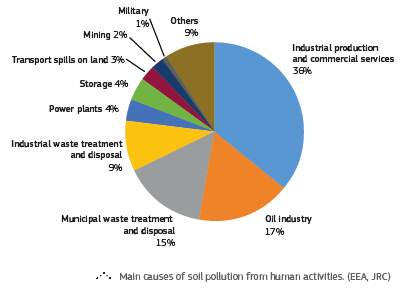Types of pollutants
Soil is an extremely complex environment, which provides soil organisms with food, water, air and shelter. Because of its properties, pollutants that end up on top of or in the soil, can have very strong immediate and long-lasting effects on soil biodiversity. The most common types of soil pollutants are oil, pesticides, heavy metals and very high concentrations of salts and fertilisers, caused primarily by industry and municipal waste.
Often the term ‘pollution’ is confused with the term ‘contamination’. Pollution can be defined as the introduction by humans, directly or indirectly, of substances or energy into the environment resulting in deleterious effects on living resources, hazards to human health and restrictions to human activities, including farming. Contamination, by contrast, is the presence of concentrations of harmful substances above the natural background level for the considered environment and the organisms living in it. A large range of pollutants can reach the soil of both natural and modified ecosystems through various routes and influence the functioning of soils on a wide spatio-temporal scale, from individual organisms to landscapes.
Effects on soil biodiversity
The impact of pollution on soil biodiversity depends on the type of pollutant and the way it acts on the soil organisms. Oil spills that create a film on the soil block gas exchanges such that it creates a lack of air and suffocates the soil biota in a non-selective way. Pesticides, by contrast, are more selective, killing specific groups of soil organisms as a side effect of their main targets of plant pathogens and pests. For example, insecticides kill insects, nematicides kill nematodes, fungicides kill fungi, bactericides kill bacteria and acaricides kill mites. It is important to note that soil organisms can develop resistance to pesticides, especially if their starting populations are large, their rate of reproduction is high and their method of overcoming pesticide activity requires few adaptations.
Heavy metals interfere with the normal metabolism of plants and soil organisms, resulting in lethal physiological and neurological disorders. The very specific impact depends on the heavy metal in question and its availability. Apart from mining, landfills and industrial sites are also potential hotspots for heavy metal pollution in the soil. Regulations on the type of waste that ends up in landfills and the recycling of waste to reuse the heavy metals are therefore of major importance.
In conclusion, whatever the pollutant, it is important to consider that the impacts on soil biodiversity do not only act via direct toxicity, which either instantly kills soil biota or leads to its reproductive failure, but also have indirect effects on non-target organisms. As soil organisms are dependent on each other through feeding relations, the alteration of any of the components of the food web can impact the rest of the chain. For example, when plant growth is not possible due to high concentrations of pollutants, the abundance of the soil organisms declines because of their dependency on the plant-derived organic matter.
Ref: A Global Atlas of Soil Biodiversity p119

